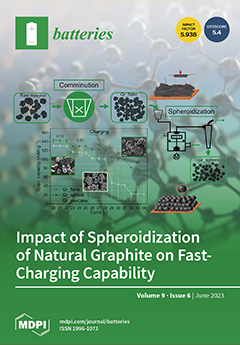Sustainable organic materials have gained considerable attention as electrodes for zinc-ion batteries (ZIB) due to their high theoretical capacity, structural versatility, and environmental friendliness. However, issues of inferior capacities and poor rate performance owing to limited inherent electronic conductivity and severe dissolution still
[...] Read more.
Sustainable organic materials have gained considerable attention as electrodes for zinc-ion batteries (ZIB) due to their high theoretical capacity, structural versatility, and environmental friendliness. However, issues of inferior capacities and poor rate performance owing to limited inherent electronic conductivity and severe dissolution still persist. Herein, sandwich-structured perylene diimide-ethylene diamine/graphene (PDI-EDA/EG) composites are judiciously designed and synthesized. The two-dimensional graphene host can interact with the PDI-EDA polymer through
π–π stacking, endowing accelerated ion/electron transfer, abundant active sites, excellent structural integrity, and mitigated solubility of the hybrid electrodes. When evaluated as an anode in ZIB, the hybrid electrode delivers a high capacity (110.2 mAh g
−1 at 0.1 A g
−1), superior rate capability (88.9 mAh g
−1 at 5 A g
−1), and exceptional durability (93.4% capacity retained after 1000 cycles). The structure evolution of the hybrid electrode during the insertion/extraction cycle was investigated by ex-situ Fourier transform infrared spectra (FTIR) and X-ray photoelectron spectroscopy (XPS), revealing the reversible Zn
2+ storage at carbonyl sites. In addition, a prototype rocking-chair ZIB cell was constructed with a zinc pre-intercalated MnO
2 cathode, displaying an ultrahigh energy density of 54.9 Wh kg
−1 at a power density of 42.5 W kg
−1 and excellent stability with negligible capacity decay after 1000 cycles.
Full article





